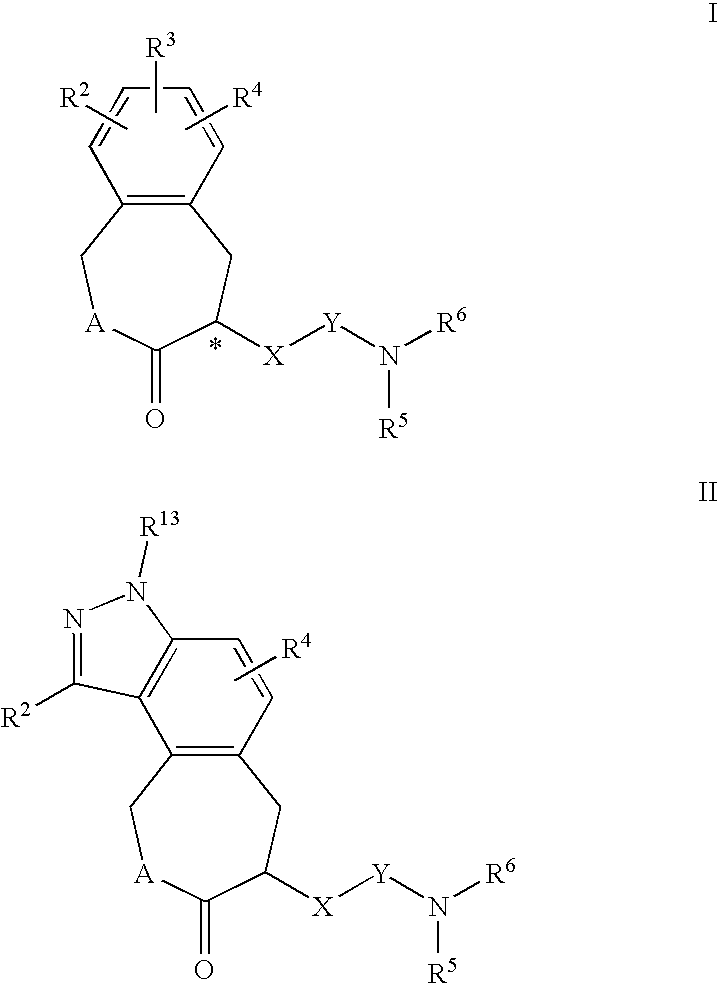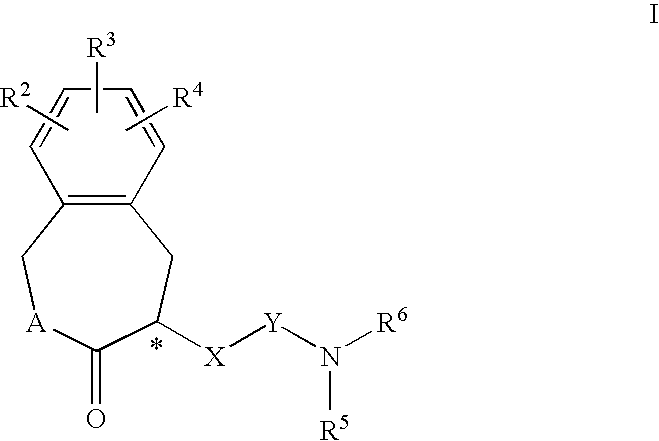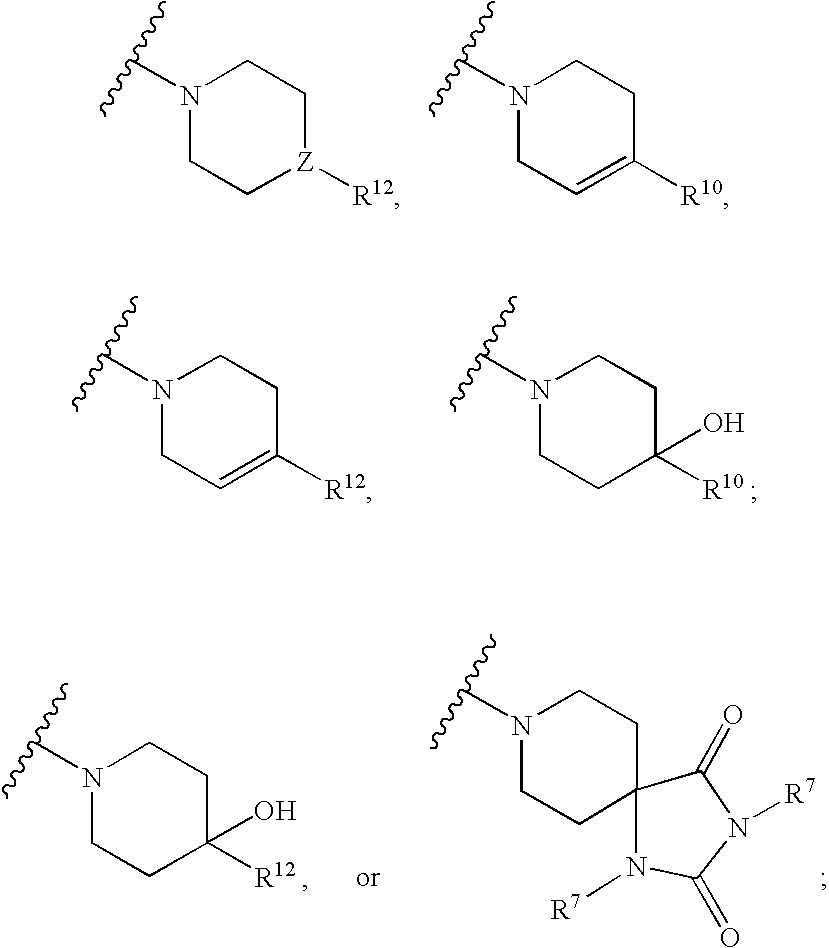Constrained compounds as cgrp-receptor antagonists
a technology of cgrp receptor and restricted compounds, which is applied in the field of restricted compounds as cgrpreceptor antagonists, can solve the problems of lack of molecular evidence and cgrp2 receptor
- Summary
- Abstract
- Description
- Claims
- Application Information
AI Technical Summary
Problems solved by technology
Method used
Image
Examples
example 1
[0328]
[0329](S)-4-chloro-7-(2-oxo-2-(4-(2-oxo-1,2,4,5-tetrahydrobenzo[d][1,3]diazepin-3-yl)piperidin-1-yl)ethyl)-9-(2,2,2-trifluoroethyl)-6,7,9,10-tetrahydroazepino[3,4-e]indazol-8(3H)-one. [4-Chloro-3,6,7,8,9,10-hexahydro-8-oxo-9-(2,2,2-trifluoroethyl)-2,3,9-triaza-(S)-cyclohepta[e]inden-7-yl]acetic acid (170 mg, 0.452 mmol) was dissolved in N,N-dimethylformamide (4.0 mL). N,N-Diisopropylethylamine (300 μl, 1.722 mmol) was added to the mixture followed by TBTU (152 mg, 0.473 mmol). 3-(Piperidin-4-yl)-4,5-dihydro-1H-benzo[d][1,3]diazepin-2(3H)-one (155 mg, 0.632 mmol) was then added to the mixture. Reaction stirred at room temperature for 45 minutes. Reaction was quenched with 50% acetonitrile-water. Mixture was purified by reverse phase prep HPLC (acetonitrile-water-trifluoroacetic acid). Acetonitrile was removed from the fractions by roto-vap. Remaining aqueous was made basic with sodium bicarbonate. Material was extracted twice with ethyl acetate. Organics were dried MgSO4, filte...
example 2
[0330]
[0331](S)-4-chloro-7-(2-oxo-2-(4-(2-oxo-3-phenyl-2,3-dihydroimidazol-1-yl)piperidin-1-yl)ethyl)-9-(2,2,2-trifluoroethyl)-6,7,9,10-tetrahydroazepino[3,4-e]indazol-8(3H)-one. [4-Chloro-3,6,7,8,9,10-hexahydro-8-oxo-9-(2,2,2-trifluoroethyl)-2,3,9-triaza-(S)-cyclohepta[e]inden-7-yl]acetic acid (97 mg, 258 μmol) was dissolved in N,N-dimethylformamide (1.5 mL). N,N-Diisopropylethylamine (45 μl, 258 μmol) was added to the mixture followed by 3-phenyl-1-(piperidin-4-yl)-1H-imidazol-2(3H)-one hydrochloride (86 mg, 307 μmol). Reaction stirred at room temperature for 3.5 hours. Mixture was diluted with 50% water-acetonitrile. Mixture was purified by reverse phase prep HPLC (acetonitrile-water-ammonium acetate). Acetonitrile was removed from the fractions by roto-vap. Remaining aqueous was diluted with water. Solids were filtered off and washed with water. Solids were collected and dried in vacuo. Title compound was obtained as white solid in 24% yield. 1H NMR (500 MHz, DMSO-D6) δ ppm 13.5...
example 3
[0332]
[0333](S)-4-chloro-7-(2-oxo-2-(4-(2-oxo-2,3-dihydroimidazol-1-yl)piperidin-1-yl)ethyl)-9-(2,2,2-trifluoroethyl)-6,7,9,10-tetrahydroazepino[3,4-e]indazol-8(3H)-one. 1-(Piperidin-4-yl)-1H-imidazol-2(3H)-one hydrochloride (80 mg, 0.393 mmol) was suspended in a mixture of N,N-diisopropylethylamine (33.5 μl, 0.192 mmol) and N,N-dimethylformamide (2.0 mL). [4-Chloro-3,6,7,8,9,10-hexahydro-8-oxo-9-(2,2,2-trifluoroethyl)-2,3,9-triaza-(S)-cyclohepta[e]inden-7-yl]acetic acid (72 mg, 0.192 mmol) was then dissolved in the mixture. TBTU (61.5 mg, 0.192 mmol) was added to the mixture, which quickly became homogenous. Reaction stirred at room temperature for 3 hours. Reaction was quenched with 50% acetonitrile-water. Mixture was purified by reverse phase prep HPLC (acetonitrile-water-ammonium acetate). Acetonitrile was removed from the fractions by roto-vap. Residue was extracted twice with ethyl acetate. Organics were dried MgSO4, filtered and then concentrated to dryness. Title compound wa...
PUM
 Login to View More
Login to View More Abstract
Description
Claims
Application Information
 Login to View More
Login to View More - R&D
- Intellectual Property
- Life Sciences
- Materials
- Tech Scout
- Unparalleled Data Quality
- Higher Quality Content
- 60% Fewer Hallucinations
Browse by: Latest US Patents, China's latest patents, Technical Efficacy Thesaurus, Application Domain, Technology Topic, Popular Technical Reports.
© 2025 PatSnap. All rights reserved.Legal|Privacy policy|Modern Slavery Act Transparency Statement|Sitemap|About US| Contact US: help@patsnap.com



